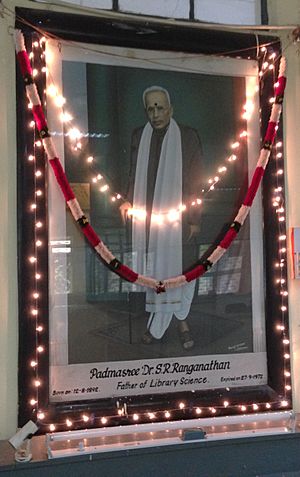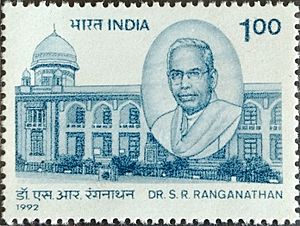S. R. Ranganathan facts for kids
Quick facts for kids
S. R. Ranganathan
|
|
|---|---|

S. R. Ranganathan's Portrait at City Central Library, Hyderabad, Chennai
|
|
| Born | Shiyali Ramamrita Ranganathan 9 August 1892 shiyali, British India (present-day Tamil Nadu, India) |
| Died | 27 September 1972 (aged 80) Bangalore, India |
| Occupation | Librarian, author, academic, mathematician |
| Nationality | Indian |
| Genre | Library Science, Documentation, Information Science |
| Notable works | Prolegomena to Library Classification The Five Laws of Library Science Colon Classification Ramanujan: the Man and the Mathematician Classified Catalogue Code: With Additional Rules for Dictionary Catalogue Code Library Administration Indian Library Manifesto Library Manual for Library Authorities, Librarians, and Library Workers Classification and Communication Headings and Canons; Comparative Study of Five Catalogue Codes |
| Notable awards | Padma Shri in (1957) |
Shiyali Ramamrita Ranganathan (born August 9, 1892 – died September 27, 1972) was a famous librarian and mathematician from India. He is often called the "Father of Library Science in India." His most important ideas were his five laws of library science and a new way to organize books called the colon classification.
Ranganathan worked as a university librarian and a professor. He taught at Banaras Hindu University (1945–47) and the University of Delhi (1947–55). At Delhi, he led the first Indian school to offer advanced degrees in library science. He was also the president of the Indian Library Association from 1944 to 1953. Every year, his birthday is celebrated as National Librarian's Day in India.
Early Life and Learning
S. R. Ranganathan was born on August 9, 1892, in a place called Siyali (now Sirkazhi) in British-ruled India. Even though some records show August 12, he wrote August 9 as his birth date in his own book, The Five Laws of Library Science.
He started his career as a mathematician. He earned his B.A. and M.A. degrees in mathematics from Madras Christian College. After that, he got a teaching license. His dream was always to teach math. He taught mathematics at universities in Mangalore, Coimbatore, and Madras. He even published papers about the history of mathematics. Ranganathan had a stammer, which made teaching a bit hard at first, but he worked hard to overcome it. In 1957, the Indian government gave him the Padma Shri award for his great work in library science.
Becoming a Librarian
In 1923, the University of Madras needed someone to manage their large, unorganized book collection. They created a new job: University Librarian. Ranganathan was one of 900 people who applied. No one had formal training in library work. Ranganathan had only read an Encyclopædia Britannica article about libraries a few days before his interview!
He wasn't very keen on the job at first. He even forgot he had applied! But he got the job in January 1924. At first, he found the quiet library work very boring. He missed teaching math and asked for his old job back. The university made a deal: he would go to London to learn about modern library practices. If he still didn't like it, he could go back to teaching math.
Ranganathan went to University College London. This was the only place in Britain that offered a graduate degree in library science. He wasn't the best student, but his math skills helped him look at how books were organized. He saw problems with the popular Dewey Decimal Classification (DDC). He started thinking of new ways to classify information.
He realized that one book could be put into many different categories. For example, a book about "warfare in India" could be about "warfare" or "India." He believed a better system was needed. This system should look at every part of a book's topic. This idea was a huge step forward for finding information, especially with the limited technology back then.
While in England, he started creating his own system, which later became the colon classification. He even reorganized the ship's library on his way back to India! He got the idea for his system after seeing a Meccano toy set in a London shop. Ranganathan returned to India excited about libraries. He saw how important they could be for his country.
He worked as the University Librarian at the University of Madras for 20 years. During this time, he helped start the Madras Library Association. He also pushed for free public libraries across India and for a national library.
Many people thought Ranganathan was a workaholic. For two decades in Madras, he worked 13 hours a day, seven days a week. He never took a vacation. He even went back to work the afternoon after his wedding in November 1928! A few years later, he and his wife Sarada had a son.
During his first years at Madras, he thought deeply about how to manage libraries and classify books. This led to his two most famous ideas: his five laws of library science (1931) and the colon classification system (1933).
Ranganathan's changes to libraries helped more people get educated. They made information available to everyone, including women and minority groups.
Later Career and Impact
After 20 years in Madras, Ranganathan left his job because of disagreements with a new university leader. He was 54 years old. After a short time feeling down, he accepted a new job. In August 1945, he became a professor of library science at Banaras Hindu University in Varanasi. This was his last official teaching job. While there, he personally classified over 100,000 books!
Ranganathan led the Indian Library Association from 1944 to 1953. However, he wasn't always the best at managing things. He left after the Delhi Public Library decided to use the Dewey Decimal Classification instead of his Colon Classification. From 1949 to 1955, he was an honorary professor at Delhi University. He helped build their library science programs with his former student, S. Dasgupta.
From 1955 to 1957, Ranganathan lived briefly in Zurich, Switzerland. This time helped him connect with other librarians in Europe. He gained many followers there. He soon returned to India and lived in Bangalore for the rest of his life. While in Zurich, he set up a special professorship at Madras University to honor his wife.
Ranganathan's last big achievement was creating the Documentation Research and Training Centre. This was a new department and research center at the Indian Statistical Institute in Bangalore in 1962. He was its honorary director for five years. In 1965, the Indian government gave him a special title: "National Research Professor." This showed how much they valued his work.
In his final years, Ranganathan was often sick and stayed in bed. He passed away on September 27, 1972, from problems related to bronchitis.
On the 100th anniversary of his birth in 1992, many books and essays were published about his life and his important ideas. Ranganathan's own story, published over time, is called A Librarian Looks Back. He dedicated his book The Five Laws of Library Science to his math teacher, Edward Burns Ross.
See also
 In Spanish: Ranganathan para niños
In Spanish: Ranganathan para niños


